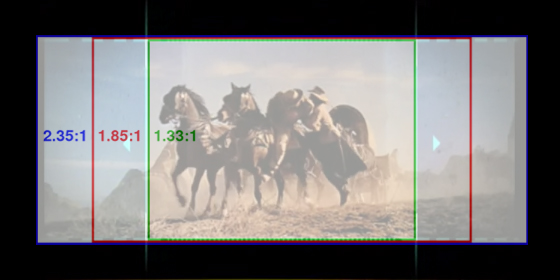Almost every film we see now is in widescreen, but how did this look come about?
With the proliferation of widescreen television over the last decade, it is sometimes easy to forget that until relatively recently films were cropped for home viewing.
This meant that for a lot of movies, a large percentage of the rectangular image (in the aspect ratios of 2:35 and 1:85) was removed so it could fit the squarer aspect of television (the 1:33 or 4:3 ratio).
The roots of this are historical, as the advent of television in the 1950s forced Hollywood to come up with newer ways of enticing audiences back to cinemas.
Thus modern widescreen processes were invented to put an image on screen that couldn’t be replicated in the homes of the time.
This shifted the fundamental look of films from the traditional academy ratio of 1:33 to the more rectangular widescreen look we now take for granted.
But when it came to screening those movies on television (ironically the very medium that triggered widescreen developments) there was the obvious problem of converting that wide image on to a square TV screen.
Here Sydney Pollack and Martin Scorsese (and others) explain for TCM the whole business of ‘pan and scanning’ and why it was bad for certain movies (by the way, Curtis Hanson’s example of The Last Supper painting is pure genius):
Back in 1992, there was a TV programme where several directors discussed why they shot certain films in widescreen, including Michael Mann (Manhunter, The Last of the Mohicans), Phillip Noyce (Dead Calm), John Boorman (Point Blank) and John Carpenter (Halloween).
They discuss how the advent of a wider screen affected their visual approach to making films, but also how it influenced such things as editing, dialogue and even running time.
What’s interesting is that Mann’s comment about widescreen televisions in Japan is now the reality.
Certain films such as Gus Van Sant’s Elephant (2003) and Andrea Arnold’s Fish Tank (2009) and The Artist (2011) actually used the squarer visual format (a.k.a. 1:33 or academy ratio) for effect.
Going back to the 1970s and 80s, directors like Stanley Kubrick (e.g. The Shining and Barry Lyndon) and William Friedkin (e.g. Sorcerer) were careful to frame some of their films so they couldn’t be awkwardly pan and scanned, although this created subsequent problems for DVD and Blu-ray releases.
Having grown up in the era of VHS and ‘squarer films’ on television, I instinctively prefer the look of widescreen, possibly because it reminds me of the cinema experience, where you could see the full image and got much better sound.
There’s also the crucial matter of actually seeing the film the way the director intended it to look.
It still often depends on the individual film, with Citizen Kane (1941) perhaps being the most ingenious use of the camera in the 1:33 ratio (as mentioned in the above clips both Welles, Howard Hawks and Fritz Lang were sceptical of Cinemascope).
But with widescreen now ubiquitous in our homes and cinemas is there going to be another shift in the frame through which we see movies?
> Find out more about widescreen formats at the Widescreen museum
> More on cinema of the 1950s at Wikipedia
> Review of Ben Hur on Blu-ray
